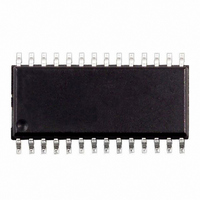E-L6919ETR STMicroelectronics, E-L6919ETR Datasheet - Page 8

E-L6919ETR
Manufacturer Part Number
E-L6919ETR
Description
IC CTRLR 5BIT PROG 2PHASE 28SOIC
Manufacturer
STMicroelectronics
Type
Step-Down (Buck)r
Datasheet
1.E-L6919ETR.pdf
(33 pages)
Specifications of E-L6919ETR
Internal Switch(s)
No
Synchronous Rectifier
Yes
Number Of Outputs
1
Voltage - Output
0.8 ~ 1.55 V
Current - Output
2A
Frequency - Switching
150kHz
Voltage - Input
5 ~ 12 V
Operating Temperature
-40°C ~ 150°C
Mounting Type
Surface Mount
Package / Case
28-SOIC (7.5mm Width)
Power - Output
2W
Mounting Style
SMD/SMT
Operating Supply Voltage
6.5 V
Maximum Operating Temperature
85 C
Minimum Operating Temperature
- 40 C
Lead Free Status / RoHS Status
Lead free / RoHS Compliant
Other names
497-4592-2
Available stocks
Company
Part Number
Manufacturer
Quantity
Price
L6919E
DEVICE DESCRIPTION
The device is an integrated circuit realized in BCD technology. It provides complete control logic and protections for
a high performance dual-phase step-down DC-DC converter optimized for microprocessor power supply. It is de-
signed to drive N Channel MOSFETs in a dual-phase synchronous-rectified buck topology. A 180 deg phase shift is
provided between the two phases allowing reduction in the input capacitor current ripple, reducing also the size and
the losses. The output voltage of the converter can be precisely regulated, programming the VID pins, from 0.825V to
1.575V with 25mV binary steps, with a maximum tolerance of ±0.6% over temperature and line voltage variations. The
device automatically regulates 25mV higher than the HAMMER DAC avoiding the use of any external set-up resistor.
The device manages On-The-Fly VID Code changes stepping to the new configuration following the VID table with no
need for external components. The device provides an average current-mode control with fast transient response. It
includes a 150kHz free-running oscillator. The error amplifier features a 15V/ s slew rate that permits high converter
bandwidth for fast transient performances. Current information is read across the lower mosfets RdsON or across a
sense resistor in fully differential mode. The current information corrects the PWM output in order to equalize the av-
erage current carried by each phase. Current sharing between the two phases is then limited at ±10% over static and
dynamic conditions. The device protects against Over-Current, with an OC threshold for each phase, entering in con-
stant current mode. Since the current is read across the low side mosfets, the constant current keeps constant the
bottom of the inductors current triangular waveform. When an under voltage is detected the device latches and the
FAULT pin is driven high. The device performs also Over-Voltage protection that disables immediately the device turn-
ing ON the lower driver and driving high the FAULT pin.
OSCILLATOR
The switching frequency is internally fixed at 150kHz. Each phase works at the frequency fixed by the oscillator so
that the resulting switching frequency at the load side results in being doubled.
The internal oscillator generates the triangular waveform for the PWM charging and discharging with a constant cur-
rent an internal capacitor. The current delivered to the oscillator is typically 25 A (Fsw=150kHz) and may be varied
using an external resistor (ROSC) connected between OSC pin and GND or Vcc. Since the OSC pin is maintained at
fixed voltage (Typ. 1.237V), the frequency is varied proportionally to the current sunk (forced) from (into) the pin con-
sidering the internal gain of 6KHz/ A.
In particular connecting it to GND the frequency is increased (current is sunk from the pin), while connecting ROSC
to Vcc=12V the frequency is reduced (current is forced into the pin), according to the following relationships:
Note that forcing a 25 A into this pin, the device stops switching because no current is delivered to the oscillator.
Figure 1. R
8/33
14000
12000
10000
8000
6000
4000
2000
OSC
0
R
25
R
O SC
vs. Switching Frequency
O SC
vs. 12V: f
50
vs. GND: f
Frequency (KHz)
75
S
100
=
S
150kHz
=
150 kHz
125
150
–
12 1.237
-------------------------- - 6
+
R
--------------- 6
R
1.237
–
O SC
O SC
kH z
---------- -
kHz
---------- -
A
800
700
600
500
400
300
200
100
A
0
150
=
=
150kHz
150 kHz
250
Frequency (KHz)
+
350
–
----------------------------- -
R
7.422 10
----------------------------- -
R
O SC
6.457 10
O SC
450
K
K
6
7
550
650













